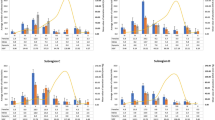Summary
The investigations on the structure of TBE foci were carried out in the localities Jívová (northern Moravia), Topolčianky and Žírany (Tribeč Mountains), and environs of Debreczén (Pannonian lowland, Hungary). The biphasic activity curve of Ixodes ricinus, characteristic for the central European conditions was confirmed in all three types.
In some localities two or three tick species as vectors come into consideration and the unequal seasonal occurrence of individual species results in a permanent presence of virus-harbouring ticks in nature throughout the year.
The average population density of ticks per hectare in a focus near topolčianky in mid-April, 1969, reached 46,000 nymphae and 50,000 adults. About 1% of the tick population were found to be viruliferous.
Great differences were found in the composition of plant communities, mammalian synusies and in the population density of small mammals and ticks within the regions studied.
Each elementary focus consists of many “microfoci” where the territories of individual host species overlap in space and time. Nests in tree holes and underground probably also belong to these microfoci. The maintenance hosts and indicators in each type of focus are mentioned. Free-living Carnivora can be considered as incidental hosts in each type of focus.
Similar content being viewed by others
References
Audy, R.: Types of human influence on natural foci of disease. Proceedings of a Symposium in Prague, November 26–29, 1963, p. 245–251 (1965).
Blaškovič, D., Nosek, J.: The ecological approach to the study of natural focality of tick-borne encephalitis. Progress in virology (1969) (in press).
Ernek, E., Kožuch, O., Nosek, J., Hudec, K.: The relation between tick-borne encephalitis virus and the wild duck (Anas platyrhynchos L.). I. Acute infection. Acta virol. 13, 296–302 (1969).
Grešíková, M., Kožuch, O., Nosek, J.: Die Rolle von Ixodes ricinus als Vektor des Zeckenencephalitisvirus in verschiedenen mitteleuropäischen Naturherden. Zbl. Bakt., I. Abt. Orig. 207, 423–429 (1968).
—, Nosek, J.: Isolation of tick-borne encephalitis virus from Ixodes ricinus ticks in the Tribeč region. Bull. Wld Hlth Org. 36, Suppl. 1, 67–71 (1967).
Kožuch, O., Grulich, I., Nosek, J.: Serological survey and isolation of tick-borne encephalitis virus from the blood of the mole (Talpa europaea) in a natural focus. Acta virol. 10, 557–560 (1966a).
—, Nosek, J., Lichard, M.: Überleben des Zeckenencephalitis-Virus in der Zecke Ixodes ricinus und die Übertragung dieses Virus auf Igel (Erinaceus roumanicus). Zbl. Bakt., I. Abt. Orig. 199, 152–161 (1966b).
— Grulich, I.: Transmission of tick-borne encephalitis virus by nymphs of Ixodes ricinus to the European mole (Talpa europaea). Acta virol. 10, 183 (1966c).
— Chmela, J., Ernek, E.: Transmission of the tick-borne encephalitis virus by nymphs of Ixodes ricinus und die Übertragung dieses Virus auf den Igel (Erinaceus roumanicus). Zbl. Bakt., I. Abt. Orig. 199, 152–161 (1966b).
—, Grulich, I.: Transmission of tick-borne encephalitis virus by nymphs of Ixodes ricinus to the European mole (Talpa europaea). Acta virol. 10, 183 (1966c).
—, Chmela, J., Ernek, E.: Transmission of the tick-borne encephaolitis virus with nymphs of Ixodes ricinus and Haemaphysalis inermis to the common shrew Sorex araneus. Acta virol. 11, 256–259 (1967a).
—: Experimental infection of Pitymys subterraneus with tick-borne encephalitis virus. Acta virol. 11, 464–466 (1967b).
—, Ernek, E., Lichard, M.: The importance of goats in the maintenance of tick-borne encephalitis virus in nature. Acta virol. 11, 470–472 (1967a).
—, Radda, A.: Synökologische Untersuchungen in Naturherden des Frühsommer-Meningoenzephalitis-Virus vom Karpatischen Typus. Zbl. Bakt., I. Abt. Orig. 209, 293–299 (1969).
Libíková, H.: Assay of the tick-borne encephalitis virus in HeLa cells. III. Selection and properties of virus antigens an in vitro neutralization test. Acta virol. 7, 516–524 (1963).
Michielsen, N. C.: Intraspecific and interspecific competition in the shrews Sorex araneus L. and Sorex minutus L. Arch. néerl. Zool. 17, 73–174 (1966).
Nosek, J., Grulich, I.: Relationship between the TBE virus and the ticks and mammals of the Tribeč mountain range. Suppl. of the Bull. Wld Hlth Org. 36, 31–47 (1967).
Nosek, J., Kožuch, O.: The use of carbon dioxide for collecting of ticks. Zbl. Bakt., I. Abt. Orig. 211, 400–402 (1969).
—, Ernek, E., Lichard, M.: The importance of goats in the maintenance of tick-borne encephalitis virus in nature. Acta virol. 11, 470–472 (1967a).
—: Übertragung des Zeckenencephalitis-Virus (TBE) durch die Weibchen von Ixodes ricinus und Nymphen Haemaphysalis inermis auf die Rehkitzen (Capreolus capreolus). Zbl. Bakt., I. Abt. Orig. 203, 162–166 (1967b).
—, Radda, A.: Untersuchungen über die Ökologie des Virus der Zentraleuropäischen Encephalitis in Nordmähren. Zbl. Bakt., I. Abt. Orig. 208, 81–87 (1968).
Pretzmann, G., Radda, A., Loew, J.: Studien zur Ökologie von Ixodes ricinus L. in einem Endemiegebiet der Frühsommermeningoenzephalitis (FSME) im Bezirk Neunkirchen (Niederösterreich). Z. Morph. Ökol. Tiere 54, 393–413 (1964).
—: Die Verteilung virustragender Zecken in Naturherden der Frühsommer-meningoenzephalitis (FSME-CEE). Zbl. Bakt., I.Abt., Orig. 203, 30–46 (1967).
Radda, A., Kunz, Ch., Neuman, G., Pretzmann, G., Zukrigl, K.: Beitrag zur Kenntnis der Syn-Ökologie des Virus der Zentraleuropäischen Encephalitis. Zbl. Bakt., I. Abt. Orig. 202, 273–296 (1967).
Rosický, B.: Natural foci of diseases. In: Infectious diseases, edit. by A. Cockburn, Springfield, Ill. USA. Ch. C. Thomas Publ. 1967.
Smith Gordon, C. E.: Contrasts in the ecology of mosquito and tick-borne infections. Proceedings of a Symposium in Prague, November 26–29, 1963 p. 165–171 (1963).
Tanaka, R.: Estimation of vole and mouse populations on Mt. Ischizuchi and the uplands of southern Shikoku. J. Mammal. 32, 450–458 (1951).
Vilček, J.: Interference between tick-borne encephalitis and Western equine encephalomyelitis viruses in chick embryo tissue cultures. Acta virol. 4, 308–310 (1960).
Author information
Authors and Affiliations
Rights and permissions
About this article
Cite this article
Nosek, J., Kožuch, O. & Grulich, I. The structure of tick-borne encephalitis (TBE) foci in Central Europe. Oecologia 5, 61–73 (1970). https://doi.org/10.1007/BF00345976
Received:
Issue Date:
DOI: https://doi.org/10.1007/BF00345976




